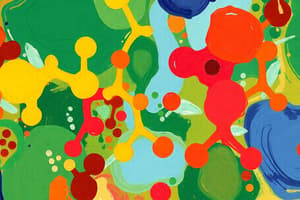Podcast
Questions and Answers
Which of the following carbohydrates is commonly known as fruit sugar?
Which of the following carbohydrates is commonly known as fruit sugar?
- Fructose (correct)
- Galactose
- Lactose
- Glucose
Which disaccharide is formed when glucose and fructose are combined?
Which disaccharide is formed when glucose and fructose are combined?
- Sucrose (correct)
- Lactose
- Glycogen
- Maltose
What is the primary function of glycogen in animals?
What is the primary function of glycogen in animals?
- Facilitates digestion of fats.
- Provides structural support to cell walls.
- Functions as a component of genetic material.
- Serves as a short-term energy storage. (correct)
During digestion, enzymes break down complex carbohydrates into which of the following?
During digestion, enzymes break down complex carbohydrates into which of the following?
Which carbohydrate serves as the storage form of energy in plants?
Which carbohydrate serves as the storage form of energy in plants?
Flashcards
Monosaccharides
Monosaccharides
Simple sugars that cannot be broken down further by hydrolysis.
Glucose
Glucose
Glucose is a monosaccharide that is a primary source of energy for the body.
Disaccharides
Disaccharides
Sugars composed of two monosaccharides joined by a glycosidic bond.
Sucrose
Sucrose
Signup and view all the flashcards
Polysaccharides
Polysaccharides
Signup and view all the flashcards
Study Notes
- Monosaccharides include glucose, fructose (fruit sugar), and galactose.
- Disaccharides include sucrose (table sugar, sweeteners), maltose, and lactose (milk sugar).
- Polysaccharides include glycogen, which is the storage form of sugar in animals.
- Starch, a polysaccharide, acts as the storage form of sugar in plants.
Studying That Suits You
Use AI to generate personalized quizzes and flashcards to suit your learning preferences.




